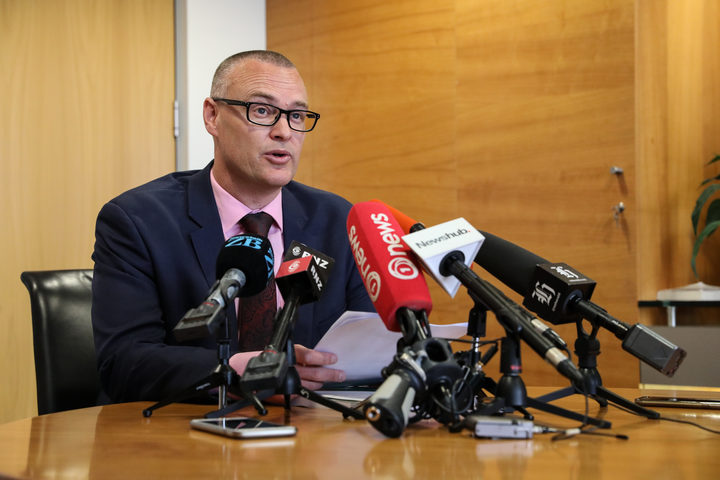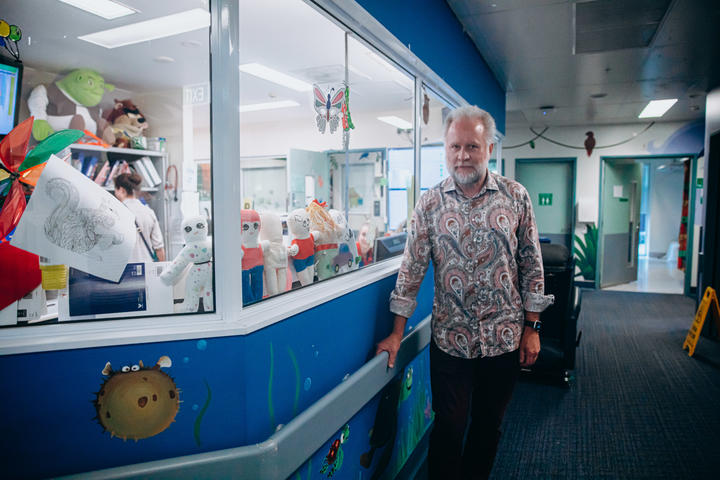Insight - The government has put $500m towards boosting health capabilities to tackle the Covid-19 crisis. But the hospitals delivering critical care are themselves in need of urgent assistance. Phil Pennington investigates.

Infrastructure manager at Palmerston North Hospital, Liam Greer, is proud of the efforts to keep older equipment working well. Photo: RNZ /Dom Thomas
Its two big blue boilers are pushing through enough steam and hot water to wash 90 tonnes of laundry a week, sterilise all the surgical instruments and enable 100 other jobs.
Nearby are two transformers, shifted out of flooding's way in the basement, and fed by new 11,000-volt cables.
Infrastructure manager Liam Greer will soon have the "juice" he needs to allow new building work to begin. He's solidly upbeat in a belt-and-braces way.
"We have enough budget, we have enough resources," he says.
Elsewhere though, the hospital is in a different situation.
Below the hum of the plant, the squeak of shoes in long hospital corridors, and laughter in the children's ward, is another underlying sound - the thrum of distress.
Palmerston North's acting chief medical officer Dr Jeff Brown experiences it daily, when he tells a patient they can't have their pain-relieving surgery because his seven, 50-year-old theatres - with ceilings so low the operating lights bump surgeons in the head - are already running at 110 percent.
"One of the things that we can be proud of is that, actually, we have maintained the pipes, the electricity, the air conditioning if it's there - we've made those efforts within the building," the paediatrician says.
Though, on this sunny morning, the temperature is already rising in most of the wards, which don't, in fact, have air-conditioning.
"There is a flip side to that," he says. "Superficially, it can look like it's well looked after.
"But when you actually stand back and look at the size of the place, the size of the actual rooms, the size of the corridors, the size of theatres and the number ... then that's where the deficiency is."
Clinical leaders at Christchurch Hospital put it more bluntly in a letter to the Minister of Health last year. "Poor facilities are negatively and drastically impacting patient care," they wrote, pleading with Wellington to stop dragging the chain over doubling the number of acute care tower blocks from two to four.
The thrum is growing louder.
Clinicians in both Hawke's Bay and Palmerston North around the same time wrote separately to the minister, their health board bosses and the Ministry of Health.
They sounded a similar alarm - that overcrowded Emergency Departments, intensive care units, and operating theatres are poised on the very edge.
"The unmet need is incredible, I don't know how New Zealanders put up with it," one of the senior doctors told RNZ.
And louder.
Listen and subscribe to Insight for free on Apple Podcasts, Spotify, iHeartRADIO, RadioPublic or wherever you listen to your podcasts
In Whangārei last month, the health board told infrastructure leaders it was short of $5-$6 million a year for short-term capital fixes, so had been forced to run its buildings to the point of "failure".
"All facilitates/areas inadequate in size," said a presentation obtained by Insight. "Facilities not fit for purpose, overcrowded, [are] compromising clinical care."
It rated six of its systems as poor, and another four "very poor" including for clinical safety, fire safety and comfort - again, a lack of ventilation in the face of rising temperatures.
Its request for a billion-dollar-plus rebuild was knocked back. The board is going back in May, with a $500-700m plan.
"Stand back and look"
The signs have been there for years, and now the government has taken a leaf out of Dr Brown's book, who said "stand back and look".The result is the first national stocktake - 25,000 entries of building items, often listing the state they are in.
Entries include:
“Auckland City Hospital, main building, hot water distribution, condition poor, estimated replacement time frame 0 to 2 years."
“Whanganui Hospital, women's and children's, windows and doors, very good condition, replacement time 10-plus years."
Walls, roofs, lifts, boilers, sprinklers - they’re all here, across 20 district health boards, rated in 10,000 cases from 1 ("very good") to 5 ("very poor), in the list obtained by RNZ.
Another 14,000 items are not rated.
A second spreadsheet sets out asbestos, fire separation, and earthquake problems.
Detailed assessments of critical facilities like Emergency Departments and ICUs will follow.
The picture emerging in the government's eyes is one that confirms earlier Treasury estimates that, just to play catch-up, the cost could be as much as $14 billion over the next decade.

Health Minister David Clark Photo: RNZ / Richard Tindiller
He must now move from a stocktake to a national asset plan, and one that sets clear spending priorities. "That is the whole purpose of this exercise."
That exercise must try to overcome long held scepticism about how priorities are set.
Decisions that have raised eyebrows include Dunedin getting the first billion-dollar-plus hospital built for more than a decade, ahead of Whangārei, while at the same time Hawke's Bay DHB is spending $5000 a year on ice blocks to keep staff cool in non-air conditioned wards.
National Party health spokesperson Michael Woodhouse concedes there had been "under both the two previous governments ... a degree of competition for capital, and limited resources in construction, the consequence of which is that some projects may have been delayed unduly.
"I think that's going to be a much more coordinated process when we have the national stocktake."
Covid-19 has only increased the pressure on Dr Clark, but at least given him money to expand ICUs.
He couldn't give a definitive timeline on when the national management plan would be in place. Big questions regarding how much health care should be in hospitals, and how much in the community, and major findings from the health and disability system review, are still ahead. "We don't want to rush this."

Palmerston North Hospital Photo: RNZ /Dom Thomas
That may not wash with Christchurch's senior doctors.
"We need urgent and fast-tracked decisions regarding our facilities," they told the minister in their blunt letter last year.
"Without this, it is important that you understand that Canterbury DHB will inevitably and dramatically be placed at risk of serious failure."
Meantime, hospitals are relying on stopgap funding, such as $26m for Palmerston North to give critical services elbow room and fund a cardiac care unit enabled by Liam Greer's new power cables.
And they are relying on managing the risks.
"Patients’ lives would be at risk if risk mitigation strategies were not in place," Dr Clark says. "Our staff do a fantastic job ... I'm not day-to-day concerned about the way in which they manage those risks."

Palmerston North's acting chief medical officer Dr Jeff Brown says the size and number of operating theatres, rooms and corridors is a problem Photo: RNZ /Dom Thomas
"You've got your sickest patients going from theatre to ICU ... going up and down lifts for four floors," Dr Brown says.
"We don't believe patients have come to harm, but we've had to become very good at looking after patients on lift rides."

Post a Comment